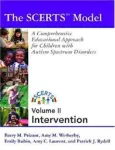| Titre : |
The SCERTSÂŪ Model. A Comprehensive Educational Approach for Children with Autism Spectrum Disorders : Volume 2 : Program Planning and Intervention |
| Type de document : |
texte imprimÃĐ |
| Auteurs : |
Barry M. PRIZANT, Auteur ; Amy M. WETHERBY, Auteur ; Emily RUBIN, Auteur ; Amy C. LAURENT, Auteur ; Patrick J. RYDELL, Auteur |
| Editeur : |
Baltimore [Etats-Unis] : Brookes Publishing |
| AnnÃĐe de publication : |
2006 |
| Importance : |
390 p. |
| Format : |
21,5cm x 28cm x 2,1cm |
| Note gÃĐnÃĐrale : |
Bibliogr. |
| Langues : |
Anglais (eng) |
| Mots-clÃĐs : |
SCERTS Model (Social Communication Emotional Regulation and Transactional Supports) |
| Index. dÃĐcimale : |
APP-D APP-D - Interventions Educatives - Généralités |
| RÃĐsumÃĐ : |
A groundbreaking synthesis of developmental, relationship-based, and skill-based approaches, The SCERTSÂŪ Model provides a framework for improving communication and social-emotional abilities in preschool and primary school students with autism spectrum disorders (ASD) and their families. Developed by internationally recognized experts, SCERTSÂŪ supports developmental progress in three areas: Social Communication (communicating spontaneously and establishing relationships), Emotional Regulation (regulating emotional arousal to support learning and engagement), and Transactional Supports (elements that aid a child's progress as he or she works toward a goal).
With the two-volume manual set, early intervention professionals will have comprehensive and practical guidance on using SCERTSÂŪ in assessment and intervention.
Volume II: Intervention gives early interventionists explicit instruction on how to help children reach their goals following assessment. They'll learn how to prioritize and set social communication and emotional regulation goals for young children; choose meaningful and purposeful activities to help them reach the goals, implement four types of transactional support (learning supports, interpersonal support, support to families, and support among professionals); and learn how to link all three SCERTSÂŪ components in program planning. In-depth vignettes on diverse children and families illustrate implementation of the model, and forms are included to help with intervention planning.
Semi-structured yet flexible enough to respond to individual differences, SCERTSÂŪ can be applied in many different settings and used with other intervention approaches. With this child- and family-centered model, based on over two decades of research and clinical experience, early interventionists will have everything they need to evaluate and promote the social and emotional development of children with ASD.
These manuals are part of The SCERTSÂŪ Model, a groundbreaking framework for improving communication and social-emotional abilities in individuals with autism spectrum disorders (ASD) and their families. Developed by internationally recognized experts, SCERTS effectively supports developmental progress in three domains: Social Communication, Emotional Regulation, and Transactional Support. [RÃĐsumÃĐ d'Auteur/Editeur] |
| Permalink : |
https://www.cra-rhone-alpes.org/cid/opac_css/index.php?lvl=notice_display&id=285 |
The SCERTSÂŪ Model. A Comprehensive Educational Approach for Children with Autism Spectrum Disorders : Volume 2 : Program Planning and Intervention [texte imprimÃĐ] / Barry M. PRIZANT, Auteur ; Amy M. WETHERBY, Auteur ; Emily RUBIN, Auteur ; Amy C. LAURENT, Auteur ; Patrick J. RYDELL, Auteur . - Baltimore [Etats-Unis] : Brookes Publishing, 2006 . - 390 p. ; 21,5cm x 28cm x 2,1cm. Bibliogr. Langues : Anglais ( eng)
| Mots-clÃĐs : |
SCERTS Model (Social Communication Emotional Regulation and Transactional Supports) |
| Index. dÃĐcimale : |
APP-D APP-D - Interventions Educatives - Généralités |
| RÃĐsumÃĐ : |
A groundbreaking synthesis of developmental, relationship-based, and skill-based approaches, The SCERTSÂŪ Model provides a framework for improving communication and social-emotional abilities in preschool and primary school students with autism spectrum disorders (ASD) and their families. Developed by internationally recognized experts, SCERTSÂŪ supports developmental progress in three areas: Social Communication (communicating spontaneously and establishing relationships), Emotional Regulation (regulating emotional arousal to support learning and engagement), and Transactional Supports (elements that aid a child's progress as he or she works toward a goal).
With the two-volume manual set, early intervention professionals will have comprehensive and practical guidance on using SCERTSÂŪ in assessment and intervention.
Volume II: Intervention gives early interventionists explicit instruction on how to help children reach their goals following assessment. They'll learn how to prioritize and set social communication and emotional regulation goals for young children; choose meaningful and purposeful activities to help them reach the goals, implement four types of transactional support (learning supports, interpersonal support, support to families, and support among professionals); and learn how to link all three SCERTSÂŪ components in program planning. In-depth vignettes on diverse children and families illustrate implementation of the model, and forms are included to help with intervention planning.
Semi-structured yet flexible enough to respond to individual differences, SCERTSÂŪ can be applied in many different settings and used with other intervention approaches. With this child- and family-centered model, based on over two decades of research and clinical experience, early interventionists will have everything they need to evaluate and promote the social and emotional development of children with ASD.
These manuals are part of The SCERTSÂŪ Model, a groundbreaking framework for improving communication and social-emotional abilities in individuals with autism spectrum disorders (ASD) and their families. Developed by internationally recognized experts, SCERTS effectively supports developmental progress in three domains: Social Communication, Emotional Regulation, and Transactional Support. [RÃĐsumÃĐ d'Auteur/Editeur] |
| Permalink : |
https://www.cra-rhone-alpes.org/cid/opac_css/index.php?lvl=notice_display&id=285 |
|  |

